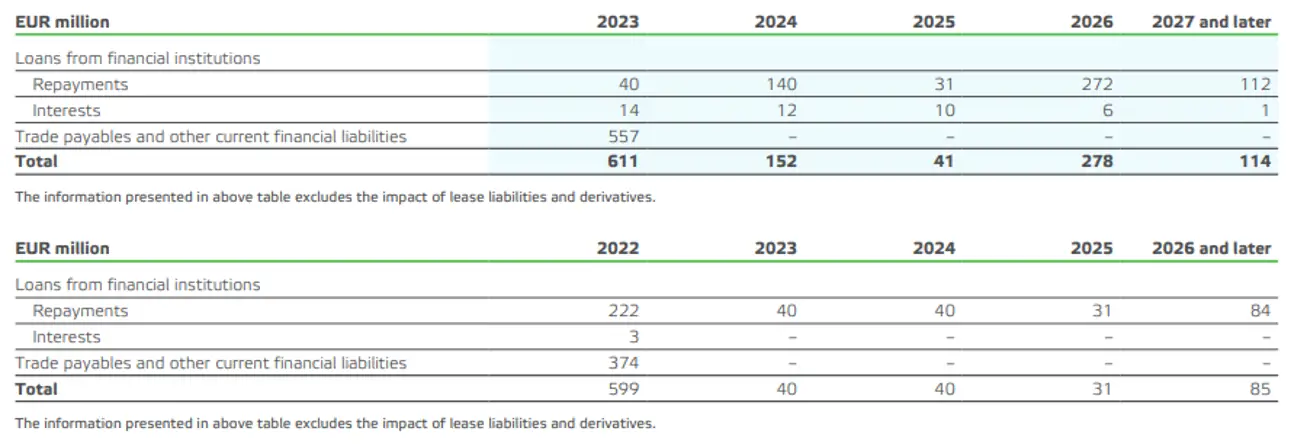Liquidity and refinancing risk management
Liquidity or refinancing risk arises when a company is not able to arrange funding at terms and conditions corresponding to its creditworthiness. Cautious maturity distribution of interest-bearing debt and sufficient cash, short-term investments and committed and uncommitted credit facilities are maintained to protect short-term liquidity and to manage refinancing risk. Diversification of funding among different markets and an adequate number of financial institutions are used to safeguard the availability of liquidity at all times. Treasury monitors bank account structures, cash balances and forecasts of the subsidiaries and manages the utilization of the consolidated cash resources.
At end of 2022 Cash and cash equivalents amounted to EUR 277 million (EUR 517 million) and current interest-bearing financial assets managed centrally by Treasury to EUR 30 million (EUR 47 million). Due to the global nature of operations, some of the Valmet subsidiaries are located in countries in which currency is subject to limited exchangeability or capital controls. Given Valmet’s total liquidity position, balances in such countries are immaterial.
In 2022, the outstanding EUR 179 million term loan was repaid and a new term loan worth EUR 50 million was withdrawn. In order to finance the completion of the merger with Neles, Valmet withdrew EUR 350 million term loan facilities. As part of the merger term loans worth of EUR 365 million were assumed by Valmet, of which EUR 150 million was repaid immediately on the merger registration date and EUR 215 million in December 2022.
Valmet’s liquidity was additionally secured by a committed and undrawn revolving credit facility worth EUR 300 million, which matures in 2025, committed and undrawn overdraft limits of EUR 16 million and an uncommitted commercial paper program worth EUR 300 million of which EUR 95 million was outstanding at the end of the reporting period.
Net working capital management is an integral part of the liquidity risk management. Treasury monitors and forecasts net working capital fluctuations in close co-operation with the subsidiaries. Net working capital increased to EUR -82 million (EUR -673 million) as at December 31, 2022, due to e.g. milestone payments for large capital projects.
Group’s refinancing risk is managed by balancing the proportion of current and non-current interest-bearing debt and average maturity of non-current interest-bearing debt including committed undrawn credit facility. The average maturity of non-current interest-bearing debt, including current portion, and committed undrawn credit facility as at December 31, 2022, was 3.3 years (4.2 years). The amount of current interest-bearing debt, including current portion of non-current interest-bearing debt, was 22 percent (53%) of total debt portfolio. As at December 31, 2022, Valmet’s interest-bearing liabilities consist of debt and lease liabilities, and debt portfolio includes only loans from financial institutions.
The tables below present undiscounted cash flows on the repayments and interests on Valmet’s financial liabilities (excl. lease liabilities and derivatives) by the remaining maturities from the balance sheet date to the contractual maturity date. The remaining maturities of lease liabilities are presented in Note 5, and correspondingly remaining maturities of derivatives in Note 9 to the Financial Statements 2022.
